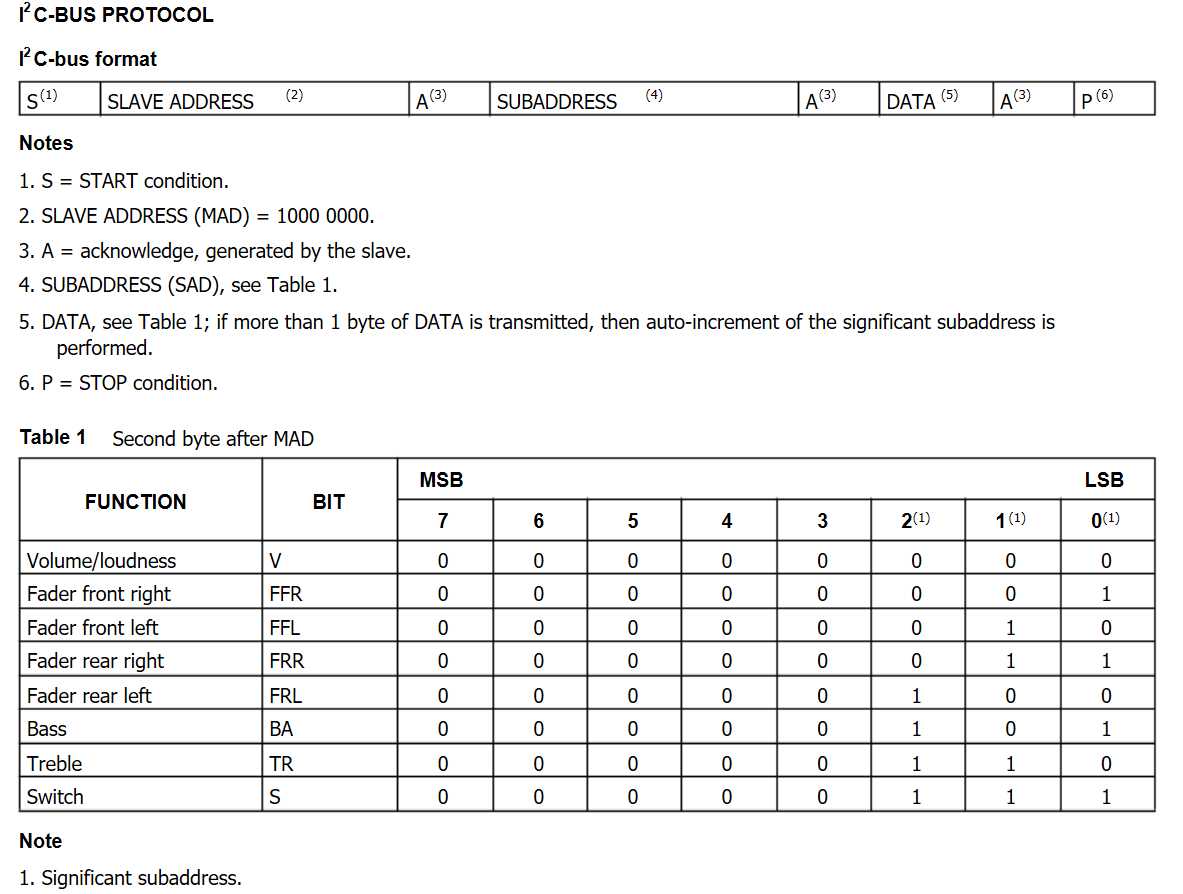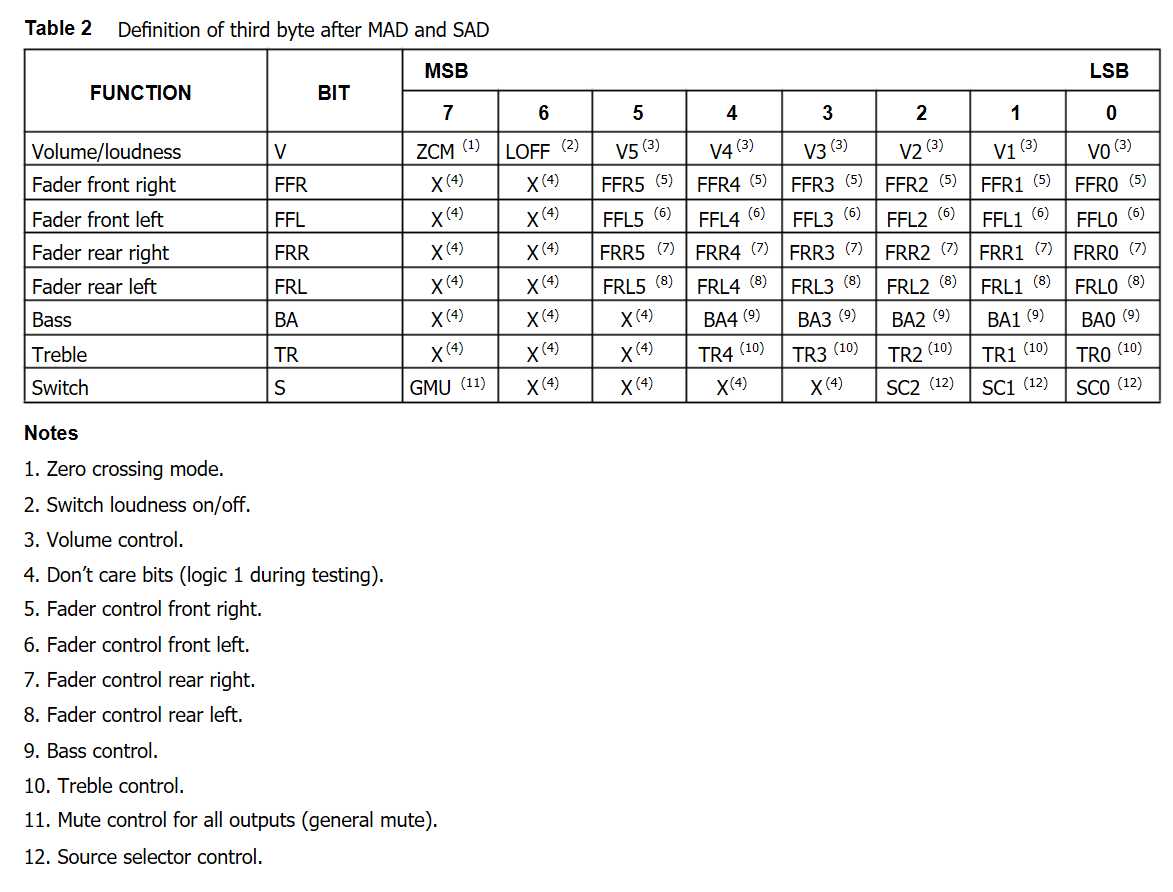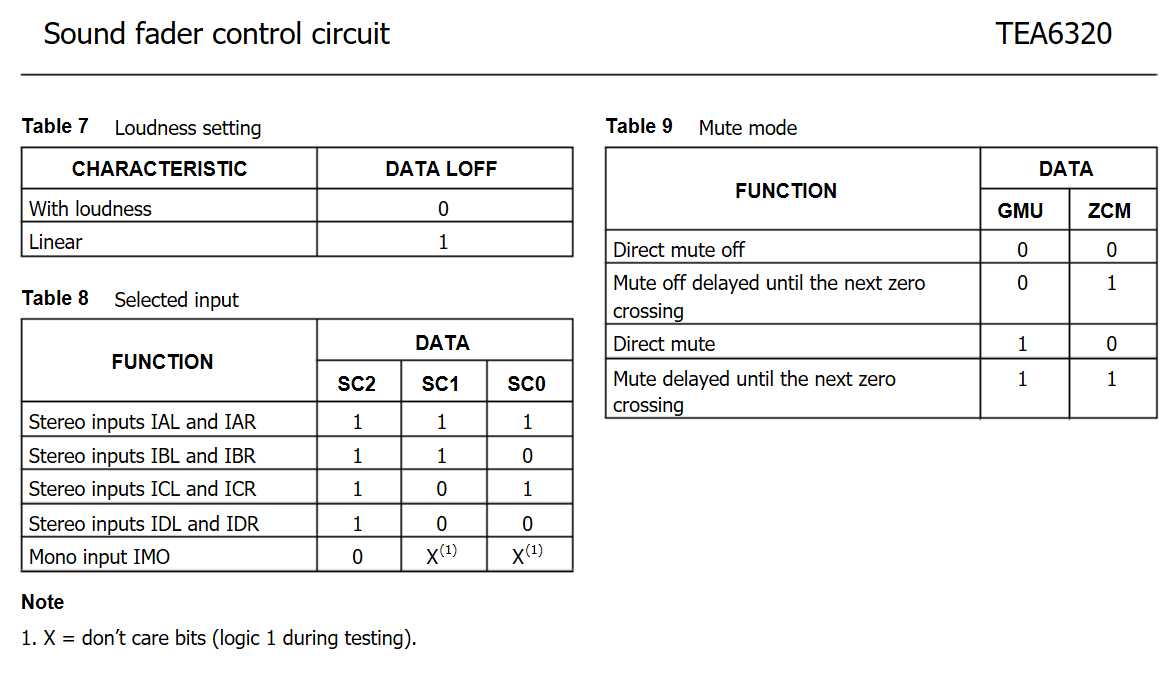關於具有I2C總線的TEA6320的使用
阿新 • • 發佈:2018-09-23
關閉 發送數據 alt 延時 初始化 spa 查找 地址 數據位
現在先了解一下TEA6320,TEA6320是一個I2C總線控制音響應用的立體聲放大器,,它的I2C協議和音量控制如下:



它的主要代碼:
void delay1ms(unsigned int Delay ) //1ms延時
{
unsigned int j;
for(;Delay>0;Delay--)
for(j=0;j<125;j++);
}
void init() ///總線初始化 將總線都拉高一釋放總線 發送啟動信號前,要先初始化總線。即總線檢測到總線空閑才開始發送啟動信號
{
SDA=1;
_nop_();
SCL=1;
_nop_();
}
void InitUART(void)
{
TMOD = 0x20; //將Timer1設置為Mode2以產生波特率
SCON = 0x50; //串口工作方式2
TH1 = 0xfd; //波特率9600
TL1 = TH1;
PCON = 0x00; //將SMOD設置為0
TR1 = 1; //開啟定時器1
EA=1; //開啟總中斷
ES=1; //開啟串口中斷
}
void SendData(uchar Dat) //發送數據
{
ACC = Dat;
CY=P;
TB8=~CY;
SBUF=ACC;
while(!TI);
TI = 0; //軟件復位
}
void I2C_start()
{
SDA=1; //起始信號
_nop_();
SCL=1;
_nop_();
_nop_();
_nop_();
_nop_();
_nop_();
SDA=0;
_nop_();
_nop_();
_nop_();
_nop_();
_nop_();
}
void I2C_stop()
{
SDA=0; //停止信號
_nop_();
SCL=1;
_nop_();
_nop_();
_nop_();
_nop_();
_nop_();
SDA=1;
_nop_();
_nop_();
_nop_();
_nop_();
_nop_();
}
void ack() //應答信號
{
SDA=0;
_nop_();
SCL=1;
_nop_();
SCL=0;
_nop_();
// SDA = 1;
// SCL = 1;
// _nop_();
// while(SDA==1);
// SCL = 0;
}
void I2C_sendByte(unsigned char dat) //發送數據
{
unsigned char temp;
unsigned char i;
SCL=0;
_nop_();
_nop_();
_nop_();
_nop_();
for(i=0;i<8;i++) //要發送的數據長度為8位
{
temp=dat;
if(temp<<i&0x80)
SDA=1; //判斷發送位
else SDA=0;
_nop_();
SCL=1; //置時鐘線為高,通知從機開始接受數據位
_nop_();
_nop_();
_nop_(); //保證時鐘高電平周期大於4us `
_nop_();
_nop_();
_nop_();
_nop_();
_nop_();
_nop_();
SCL=0; //拉低SCL,為下次數據傳輸做好準備
_nop_();
_nop_();
}
SDA=1; //釋放SDA總線,接下來由從設備控制,比如從設備接收完數據後,在SCL為高時,拉低SDA作為應答信號
_nop_();
_nop_();
_nop_();
_nop_();
}
main()
{
InitUART();
init();
while(1)
{
CS=1;
A10=0;
A11=0;
A12=0;
A13=0;
A14=0;
OE=0; /*.....ENABLE變低,總線開始接受數據.....*/
ALE=0;
bb=0;
ii=P0;
aa=0xff;
V24=0;
if(ii==0x8f) // 5個按鈕不動作,關的狀態
{
delay1ms(50);
if(ii==0x8f)
{
bb=0xf9;
P0=bb;
aa=0x11;
delay1ms(200);
CS=1;
A10=1;
A11=0;
A12=0;
A13=0;
A14=0;
WE=0;
delay1ms(500);
}
}
if(ii==0x8e)
{
delay1ms(50);
if(ii==0x8e)
{
bb=0xf1;
P0=bb;
aa=0x11;
delay1ms(200);
CS=1;
A10=1;
A11=0;
A12=0;
A13=0;
A14=0;
WE=0;
delay1ms(500);
SendData(0xAA);
I2C_start();
I2C_sendByte(0x80); //MAD,第一個字節
ack();
I2C_sendByte(0x00); //SAD,第二個字節
ack();
I2C_sendByte(0x2C); //響度 +20dB
ack();
I2C_sendByte(0x3f); //前右 響度0dB
ack();
I2C_sendByte(0x3f); //前左 響度0dB
ack();
I2C_sendByte(0x3F); //後右 響度0dB
ack();
I2C_sendByte(0x3F); //後左 響度0dB
ack();
I2C_sendByte(0x10); //低音 響度+15dB
ack();
I2C_sendByte(0x10); //高音 響度+15dB
ack();
I2C_sendByte(0x7f); //聲道選擇 直接靜音關閉,選通IAL和IAR
ack();
I2C_stop();
delay1ms(5000);
I2C_start();
I2C_sendByte(0x80); //MAD
ack();
I2C_sendByte(0x00); //SAD
ack();
I2C_sendByte(0x2C); //響度 +20dB
ack();
I2C_sendByte(0x3f); //前右 響度0dB
ack();
I2C_sendByte(0x3f); //前左 響度0dB
ack();
I2C_sendByte(0x3F); //後右 響度0dB
ack();
I2C_sendByte(0x3F); //後左 響度0dB
ack();
I2C_sendByte(0x10); //低音 響度+15dB
ack();
I2C_sendByte(0x10); //高音 響度+15dB
ack();
I2C_sendByte(0xff); //聲道選擇 直接靜音,選通IAL和IAR
ack();
I2C_stop();
SendData(0x55);
}
}
if(ii==0x8d) //4腳按鈕動作處於開的狀態
{
delay1ms(50);
if(ii==0x8d)
{
bb=0xe9;
P0=bb;
aa=0x11;
delay1ms(200);
CS=1;
A10=1;
A11=0;
A12=0;
A13=0;
A14=0;
WE=0;
delay1ms(500);
SendData(0xAA);
I2C_start();
I2C_sendByte(0x80); //MAD
ack();
I2C_sendByte(0x00); //SAD
ack();
I2C_sendByte(0x2C); //響度 +20dB
ack();
I2C_sendByte(0x3f); //前右 響度0dB
ack();
I2C_sendByte(0x3f); //前左 響度0dB
ack();
I2C_sendByte(0x3F); //後右 響度0dB
ack();
I2C_sendByte(0x3F); //後左 響度0dB
ack();
I2C_sendByte(0x10); //低音 響度+15dB
ack();
I2C_sendByte(0x10); //高音 響度+15dB
ack();
I2C_sendByte(0x7e); //聲道選擇 直接靜音關閉,選通IBL和IBR
ack();
I2C_stop();
delay1ms(5000);
I2C_start();
I2C_sendByte(0x80); //MAD
ack();
I2C_sendByte(0x00); //SAD
ack();
I2C_sendByte(0x2C); //響度 +20dB
ack();
I2C_sendByte(0x3f); //前右 響度0dB
ack();
I2C_sendByte(0x3f); //前左 響度0dB
ack();
I2C_sendByte(0x3F); //後右 響度0dB
ack();
I2C_sendByte(0x3F); //後左 響度0dB
ack();
I2C_sendByte(0x10); //低音 響度+15dB
ack();
I2C_sendByte(0x10); //高音 響度+15dB
ack();
I2C_sendByte(0xfe); //聲道選擇 直接靜音
ack();
I2C_stop();
SendData(0x55);
}
}
if(ii==0x8B) //8腳按鈕動作處於開的狀態
{
delay1ms(50);
if(ii==0x8B)
{
bb=0xd9;
P0=bb;
aa=0x11;
delay1ms(200);
CS=1;
A10=1;
A11=0;
A12=0;
A13=0;
A14=0;
WE=0;
delay1ms(500);
SendData(0xAA);
I2C_start();
I2C_sendByte(0x80); //MAD
ack();
I2C_sendByte(0x00); //SAD
ack();
I2C_sendByte(0x2C); //響度 +20dB
ack();
I2C_sendByte(0x3f); //前右 響度0dB
ack();
I2C_sendByte(0x3f); //前左 響度0dB
ack();
I2C_sendByte(0x3F); //後右 響度0dB
ack();
I2C_sendByte(0x3F); //後左 響度0dB
ack();
I2C_sendByte(0x10); //低音 響度+15dB
ack();
I2C_sendByte(0x10); //高音 響度+15dB
ack();
I2C_sendByte(0x7D); //聲道選擇 直接靜音關閉,選通ICL和ICR
ack();
I2C_stop();
delay1ms(5000);
I2C_start();
I2C_sendByte(0x80); //MAD
ack();
I2C_sendByte(0x00); //SAD
ack();
I2C_sendByte(0x2C); //響度 +20dB
ack();
I2C_sendByte(0x3f); //前右 響度0dB
ack();
I2C_sendByte(0x3f); //前左 響度0dB
ack();
I2C_sendByte(0x3F); //後右 響度0dB
ack();
I2C_sendByte(0x3F); //後左 響度0dB
ack();
I2C_sendByte(0x10); //低音 響度+15dB
ack();
I2C_sendByte(0x10); //高音 響度+15dB
ack();
I2C_sendByte(0xfD); //聲道選擇 直接靜音,選通ICL和ICR
ack();
I2C_stop();
SendData(0x55);
}
}
if(ii==0x87) //8腳按鈕動作處於開的狀態
{
delay1ms(50);
if(ii==0x87)
{
bb=0xb9;
P0=bb;
aa=0x11;
delay1ms(200);
CS=1;
A10=1;
A11=0;
A12=0;
A13=0;
A14=0;
WE=0;
delay1ms(500);
SendData(0xAA);
I2C_start();
I2C_sendByte(0x80); //MAD
ack();
I2C_sendByte(0x00); //SAD
ack();
I2C_sendByte(0x2C); //響度 +20dB
ack();
I2C_sendByte(0x3f); //前右 響度0dB
ack();
I2C_sendByte(0x3f); //前左 響度0dB
ack();
I2C_sendByte(0x3F); //後右 響度0dB
ack();
I2C_sendByte(0x3F); //後左 響度0dB
ack();
I2C_sendByte(0x10); //低音 響度+15dB
ack();
I2C_sendByte(0x10); //高音 響度+15dB
ack();
I2C_sendByte(0x7D); //聲道選擇 直接靜音關閉,選通ICL和ICR
ack();
I2C_stop();
delay1ms(5000);
I2C_start();
I2C_sendByte(0x80); //MAD
ack();
I2C_sendByte(0x00); //SAD
ack();
I2C_sendByte(0x2C); //響度 +20dB
ack();
I2C_sendByte(0x3f); //前右 響度0dB
ack();
I2C_sendByte(0x3f); //前左 響度0dB
ack();
I2C_sendByte(0x3F); //後右 響度0dB
ack();
I2C_sendByte(0x3F); //後左 響度0dB
ack();
I2C_sendByte(0x10); //低音 響度+15dB
ack();
I2C_sendByte(0x10); //高音 響度+15dB
ack();
I2C_sendByte(0xfD); //聲道選擇 直接靜音,選通ICL和ICR
ack();
I2C_stop();
SendData(0x55);
}
}
if(ii==0x0f)
{
delay1ms(50);
if(ii==0x0f)
{
bb=0x79;
P0=bb;
aa=0x11;
delay1ms(200);
CS=1;
A10=1;
A11=0;
A12=0;
A13=0;
A14=0;
WE=0;
delay1ms(500);
}
}
SendData(bb);
delay1ms(500);
if(aa==0xff)
{
P0=0x89;
CS=1;
A10=1;
A11=0;
A12=0;
A13=0;
A14=0;
WE=0